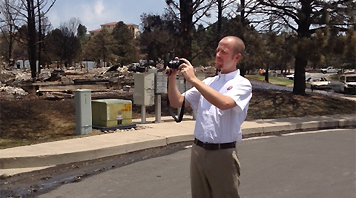|
7951 E. Maplewood Avenue, Suite 110
Greenwood Village, Colorado 80111
Serving Colorado, New Mexico, Utah & Wyoming
Contact: Carole Walker, Executive Director
303-790-0216 or toll free 800-355-9524
Devastating Twisters Sound An Alarm—Don't Wait Until Mother Nature Comes Knocking to Be "Insurance Ready" for Storm Season!
April 16, 2012 – With more than 100 tornadoes ripping through the Plains states this past weekend, 2012 is already exacting a high tornado toll—in lives lost and property devastation. Here in Colorado, tornado sirens blared last week for the first time—sounding the annual alarm that severe weather season has arrived in Colorado. Before the next round of severe weather beats a path to your door stay one step ahead of Mother Nature by getting your insurance house in order.
"We can't control Colorado's rollercoaster weather, but we can do more than just 'waiting five minutes' for it to change," says Carole Walker, Executive Director of the Rocky Mountain Insurance Information Association. "We need to take preventative steps, like considering impact resistant roofing, to protect our property and consider how much insurance coverage you have to fix your car, repair or rebuild your home and replace your personal belongings."
In recent years, Colorado has been on a record-breaking storm track that mirrors historic thunderstorm, tornado and hail damage across the country. Colorado severe storms have caused nearly $2 billion in insured losses during the past five years, with the 2009 season being the most expensive in history with $1.4 billion in estimated damage to homes and vehicles (RMIIA). U.S. thunderstorm losses in 2011 were 2.5 times above the 30-year average, at $25.8 billion. Average thunderstorm losses are more than five times higher than in the early 1980s (Munich Re).
For more information: http://www.rmiia.org/Catastrophes_and_Statistics/Hail.asp
Colorado's Most Costly Storms
With the exception of the May 22, 2008, Windsor tornado and the hailstorm that hit Pueblo on July 29, 2009, Colorado's ten most costly hailstorms were centered in the Denver Metro area (the largest concentration of property in the state).
| Date |
Location |
Cost When Occurred
(Millions) |
2011 Dollars
(Millions)* |
| July 20, 2009 |
Denver Metro |
$767.6 |
$804.8 |
| July 11, 1990 |
Denver Metro |
$625.0 |
$1.08 Billion |
| June 6-15, 2009 |
Denver Metro |
$353.3 |
$370.4 |
| June 13-14, 1984 |
Denver Metro |
$276.7 |
$599.0 |
| July 29, 2009 |
Pueblo |
$232.8 |
$244.1 |
| October 1, 1994 |
Denver Metro |
$225.0 |
$341.5 |
| May 22, 2008 |
Windsor |
$193.5 |
$202.2 |
| July 13, 2011 |
Front Range |
$164.8 |
$164.8 |
| June 8-9, 2004 |
Denver Metro |
$146.5 |
$174.4 |
| August 11, 1997 |
Denver Metro |
$128.0 |
$179.4 |
*2011 estimated cost calculations based on the Consumer Price Index.
RMIIA recommends that you take these preventative steps:
SELECT IMPACT RESISTANT ROOFING
- Your roof is the most vulnerable part of your home, so when building a new home or replacing your roof consider using impact-resistant roofing products. Most insurance companies either surcharge or only offer a percentage deductible for wood shake or non-impact resistant roofs. When hail destroys roof coverings, it can lead to water damage to your ceilings, walls, floors, appliances and personal possessions.
- The insurance industry has an impact resistant roofing Underwriters Laboratory standard ranking, the UL 2218 standard. The standard has four impact-level designations that will help you compare products. Roof coverings that show the most resistance earned a Class 4 rating; the least, a Class 1 rating.
DO AN ANNUAL INSURANCE CHECK-UP
- Insurance is something most people don't even want to think about until they need it the most. But, understanding what is and isn't covered in your homeowners' insurance policy can mean the difference of being able to rebuild your home and replace your personal belongings. Homeowners need to do annual insurance policy "check-ups" to make sure they keep up with local building costs and have adjusted their coverage to include home remodeling and additions.
- If you don't have replacement coverage, consider spending a few extra dollars for coverage that pays for the cost of replacing the damaged property without deduction for depreciation. Ask about endorsements for sewer back-up and building code upgrades.
KNOW WHAT IS & ISN'T COVERED
- The typical homeowners' insurance policy covers damage resulting from fire, windstorm, hail, water damage (excluding flooding), riots and explosion as well as other causes of loss, such as theft and the extra cost of living elsewhere while the structure is being repaired or rebuilt.
- Hail and flood damage to your car is covered only if you have purchased optional comprehensive insurance on your auto policy.
- The standard policy does not cover flooding, so you may want to look into flood insurance coverage if you're concerned that you're at risk for rising floodwaters.
CREATE A HOME INVENTORY
- Make a home inventory that includes lists, pictures or a videotape of the contents of your home or apartment. After all, would you be able to remember all the possessions you've accumulated over the years if they were destroyed by a tornado or fire? Having an up-to-date home inventory will help get your insurance claim settled faster, verify losses for your income tax return and help you purchase the correct amount of insurance.
Log on to www.rmiia.org for more information.
###
Rocky Mountain Insurance Information Association is a non-profit consumer information organization. Affiliated with the Insurance Information Institute, RMIIA has been serving consumers and the media since 1952.
|

